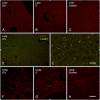Comparative Effectiveness of Intracerebroventricular, Intrathecal, and Intranasal Routes of AAV9 Vector Administration for Genetic Therapy of Neurologic Disease in Murine Mucopolysaccharidosis Type I
- PMID: 34040503
- PMCID: PMC8141728
- DOI: 10.3389/fnmol.2021.618360
Comparative Effectiveness of Intracerebroventricular, Intrathecal, and Intranasal Routes of AAV9 Vector Administration for Genetic Therapy of Neurologic Disease in Murine Mucopolysaccharidosis Type I
Abstract
Mucopolysaccharidosis type I (MPS I) is an inherited metabolic disorder caused by deficiency of the lysosomal enzyme alpha-L-iduronidase (IDUA). The two current treatments [hematopoietic stem cell transplantation (HSCT) and enzyme replacement therapy (ERT)], are insufficiently effective in addressing neurologic disease, in part due to the inability of lysosomal enzyme to cross the blood brain barrier. With a goal to more effectively treat neurologic disease, we have investigated the effectiveness of AAV-mediated IDUA gene delivery to the brain using several different routes of administration. Animals were treated by either direct intracerebroventricular (ICV) injection, by intrathecal (IT) infusion into the cerebrospinal fluid, or by intranasal (IN) instillation of AAV9-IDUA vector. AAV9-IDUA was administered to IDUA-deficient mice that were either immunosuppressed with cyclophosphamide (CP), or immunotolerized at birth by weekly injections of human iduronidase. In animals treated by ICV or IT administration, levels of IDUA enzyme ranged from 3- to 1000-fold that of wild type levels in all parts of the microdissected brain. In animals administered vector intranasally, enzyme levels were 100-fold that of wild type in the olfactory bulb, but enzyme expression was close to wild type levels in other parts of the brain. Glycosaminoglycan levels were reduced to normal in ICV and IT treated mice, and in IN treated mice they were normalized in the olfactory bulb, or reduced in other parts of the brain. Immunohistochemical analysis showed extensive IDUA expression in all parts of the brain of ICV treated mice, while IT treated animals showed transduction that was primarily restricted to the hind brain with some sporadic labeling seen in the mid- and fore brain. At 6 months of age, animals were tested for spatial navigation, memory, and neurocognitive function in the Barnes maze; all treated animals were indistinguishable from normal heterozygous control animals, while untreated IDUA deficient animals exhibited significant learning and spatial navigation deficits. We conclude that IT and IN routes are acceptable and alternate routes of administration, respectively, of AAV vector delivery to the brain with effective IDUA expression, while all three routes of administration prevent the emergence of neurocognitive deficiency in a mouse MPS I model.
Keywords: AAV9; IDUA; MPS I; gene therapy; intracerebroventricular administration; intranasal infusion; intrathecal injection.
Copyright © 2021 Belur, Romero, Lee, Podetz-Pedersen, Nan, Riedl, Vulchanova, Kitto, Fairbanks, Kozarsky, Orchard, Frey, Low and McIvor.
Conflict of interest statement
KFK was employed by REGENXBIO Inc. at the time of the study. The remaining authors declare that the research was conducted in the absence of any commercial or financial relationships that could be construed as a potential conflict of interest.
Figures










Similar articles
-
Intranasal Adeno-Associated Virus Mediated Gene Delivery and Expression of Human Iduronidase in the Central Nervous System: A Noninvasive and Effective Approach for Prevention of Neurologic Disease in Mucopolysaccharidosis Type I.Hum Gene Ther. 2017 Jul;28(7):576-587. doi: 10.1089/hum.2017.187. Epub 2017 Apr 20. Hum Gene Ther. 2017. PMID: 28462595 Free PMC article.
-
Neurologic Recovery in MPS I and MPS II Mice by AAV9-Mediated Gene Transfer to the CNS After the Development of Cognitive Dysfunction.Hum Gene Ther. 2023 Jan;34(1-2):8-18. doi: 10.1089/hum.2022.162. Hum Gene Ther. 2023. PMID: 36541357 Free PMC article.
-
Intrathecal or intravenous AAV9-IDUA/RGX-111 at minimal effective dose prevents cardiac, skeletal and neurologic manifestations of murine MPS I.Mol Ther Methods Clin Dev. 2024 Nov 4;32(4):101369. doi: 10.1016/j.omtm.2024.101369. eCollection 2024 Dec 12. Mol Ther Methods Clin Dev. 2024. PMID: 39687731 Free PMC article.
-
Intravenous delivery for treatment of mucopolysaccharidosis type I: A comparison of AAV serotypes 9 and rh10.Mol Genet Metab Rep. 2020 May 20;24:100604. doi: 10.1016/j.ymgmr.2020.100604. eCollection 2020 Sep. Mol Genet Metab Rep. 2020. PMID: 32461912 Free PMC article.
-
Mucopolysaccharidosis Type I: Current Treatments, Limitations, and Prospects for Improvement.Biomolecules. 2021 Jan 29;11(2):189. doi: 10.3390/biom11020189. Biomolecules. 2021. PMID: 33572941 Free PMC article. Review.
Cited by
-
New Indications for Hematopoietic Stem Cell Gene Therapy in Lysosomal Storage Disorders.Front Oncol. 2022 May 13;12:885639. doi: 10.3389/fonc.2022.885639. eCollection 2022. Front Oncol. 2022. PMID: 35646708 Free PMC article. Review.
-
Revolutionizing Parkinson's treatment: Harnessing the potential of intranasal nanoemulsions for targeted therapy.Drug Deliv Transl Res. 2025 Aug;15(8):2589-2607. doi: 10.1007/s13346-024-01770-z. Epub 2025 Jan 8. Drug Deliv Transl Res. 2025. PMID: 39777646 Review.
-
Mucopolysaccharidoses and the blood-brain barrier.Fluids Barriers CNS. 2022 Sep 19;19(1):76. doi: 10.1186/s12987-022-00373-5. Fluids Barriers CNS. 2022. PMID: 36117162 Free PMC article. Review.
-
Comparative dose effectiveness of intravenous and intrathecal AAV9.CB7.hIDS, RGX-121, in mucopolysaccharidosis type II mice.Mol Ther Methods Clin Dev. 2024 Jan 30;32(1):101201. doi: 10.1016/j.omtm.2024.101201. eCollection 2024 Mar 14. Mol Ther Methods Clin Dev. 2024. PMID: 38374962 Free PMC article.
-
Micro- and Nanosized Carriers for Nose-to-Brain Drug Delivery in Neurodegenerative Disorders.Biomedicines. 2022 Jul 14;10(7):1706. doi: 10.3390/biomedicines10071706. Biomedicines. 2022. PMID: 35885011 Free PMC article. Review.
References
-
- Aronovich E. L., Bell J. B., Belur L. R., Gunther R., Koniar B., Erickson D. C., et al. (2007). Prolonged expression of a lysosomal enzyme in mouse liver after sleeping beauty transposon-mediated gene delivery: implications for non-viral gene therapy of mucopolysaccharidoses. J. Gene Med. 9 403–415. 10.1002/jgm.1028 - DOI - PMC - PubMed
-
- Baldo G., Mayer F. Q., Martinelli B. Z., de Carvalho T. G., Meyer F. S., de Oliveira P. G., et al. (2013). Enzyme replacement therapy started at birth improves outcome in difficult-to-treat organs in mucopolysaccharidosis I mice. Mol. Genet. Metab. 109 33–40. 10.1016/j.ymgme.2013.03.005 - DOI - PubMed
-
- Belur L., Huber A., Mantone M., Karlen A., Smith M., Ou L., et al. (2021). Comparative systemic and neurologic effectiveness of intravenous and intrathecal AAV9 delivered individually or combined in a murine model of mucopolysaccharidosis type I. Mol. Gen. Metab. 132 S19–S20.
Grants and funding
LinkOut - more resources
Full Text Sources
Other Literature Sources
Miscellaneous

